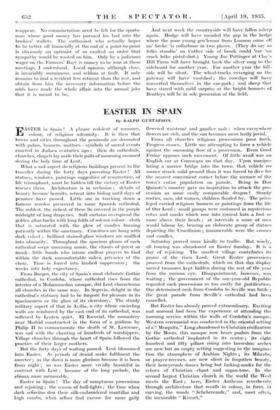EASTER IN SPAIN
By RALPH GUSTAFSON
"VASTER in Spain ! A phrase redolent of romance, colour, of religious solemnity. It is then that towns and cities throughout the peninsula arc decorated with palms, banners, mottoes—symbols of sacred events enacted in Judaea centuries ago ; then do cathedrals, churches, chapels lay aside their palls of mourning assumed during the holy. time of Lent.
What a sad aspect do religious buildings present to the traveller during the forty days preceding Easter ! All statues, windows, paintings suggestive of resurrection, of life triumphant, must be hidden till the victory of Easter rescues them. Architecture is in seclusion ; details of beauty become hermits, retreat into hiding until days of penance have passed. Little use in tracking down a famous reredos preserved in some Spanish cathedral. The noblest, the richest of these lie covered in the purple midnight of long draperies. Soft curtains overspread the golden altar-backs with long folds of solemn colour—cloth that is saturated with the glow of candles burning patiently within the sanctuary. Crucifixes are hung with dark velvet ; brilliant stained-glass windows are muffled into obscurity. Throughout the spacious gloom of each cathedral seeps unceasing music, the chants of priest or monk—little bands who intone endless prayers to God within the dark uncomfortable oaken privacics of the choir. Time is forced into hushed suppression ; the weeks into holy expectancy.
From Burgos, the city of Spain's most elaborate Gothic cathedral, to Cordoba, whose cathedral rises from the interior of a Mohammedan mosque, did Lent characterize all churches in the same way. - In Segovia, delight in the cathedral's statuary had to be forgone for pleasure in its spaciousness or the glass of its clerestory. The sturdy military aspect of that in Avilia, a city whose encircling walls are reinforced by the cast end of its cathedral, was softened by Lenten quiet. El Escorial, the monastery near Madrid constructed in the form of a gridiron by Philip II to commemorate the death of St. Lawrence, was sad with the chanting of hundreds of worshippers. Village churches through the heart of Spain followed the practice of their larger mothers.
But the forty days of waiting passed. Lent blossomed into Easter. As periods of denial make fulfilment the sweeter ; as the dawn is more glorious because it is born from night ; so was Easter more vividly beautiful in contrast with Lent ; because of the long prelude, the climax more memorable.
Easter in Spain ! The day of sumptuous processions and rejoicing ; the season of bull-fights ; the time when dark sefioritas don their silk-embroidered mantillas and high combs, when senors find excuse for more gaily flowered waistcoat and gaudier sash ; when everywhere flowers are rich, and the sun becomes more lazily jovial.
From all .churches religious processions pour forth. Progress. ceases. Little use attempting to force a vehicle against the oncoming flow of a procession. Even Good Friday opposes such movement. Of little avail was an English car at Consuegra on that day. Upon-manipu- lating a narrow bridge into the town, that vehicle no sooner struck solid ground than it was forced to dive for the nearest convenient corner before the menace of the town's entire population on parade. Being in Don Quixote's country gave no inspiration to attack the pro- cession as some easily • conquerable dragon ! Sturdy rustics, men, old women, children flooded by. The privi- leged carried religious banners or paintings from-the life of Our Lord ; small groups were costumed in mysterious robes and masks which rose into conical hats a foot or more above their heads ; at intervals a Score, of men would labour by, bearing an elaborate group of statues depicting the Crucifixion ; innumerable were the crosses and candles.
Saturday proved more kindly to traffic. But wisely, all touring was abandoned on Easter Sunday.. It is a day of rejoicing. The smallest village contributes its praise of the risen Lord. Great Easter processions proceed from the cathedrals, which on that day display sacred treasures kept hidden during the rest of the year from the curious eye. Disappointment, however,. was waiting ; the government of the one-year-old Republic regarded such processions as too costly for justification. Our determined rush from Cordoba to Seville was futile ; the great parade from Seville's cathedral had been cancelled.
But Easter has already proved extraordinary. Exciting and unusual had • been the experience of attending the morning service within the walls of Cordoba's mosque. Western ceremonial was conducted in the oriental setting of a " Mezquita." Long abandoned to Christian civilization by the Moors, this mosque now hears psalms from the Gothic cathedral implanted in its centre ; its eight hundred and fifty pillars rising into horseshoe arches are now but an empty setting suggesting to the imagina- tion the atmosphere of Arabian Nights ; its Mihrabs, or prayer-recesses, are now silent in forgotten beauty, their honeycomb domes being but lurking-nooks for the echoes • of Christian chant and organ-tone. In the second largest Christian church in the world the West meets the East ; here, Easter Anthems reverberate through architecture that recalls in colour, in form, in carving, the words " Scheherezade," and, most often, the inexorable " Kismet."






































 Previous page
Previous page